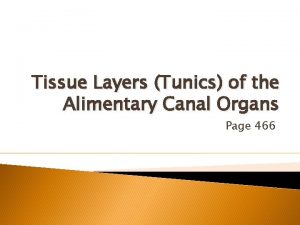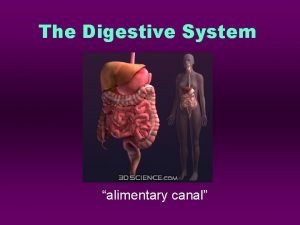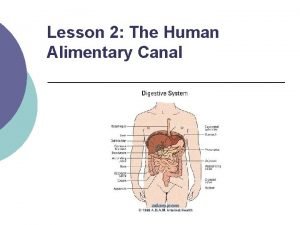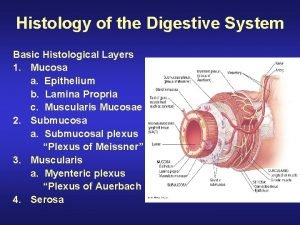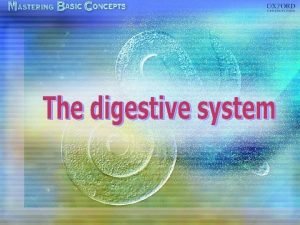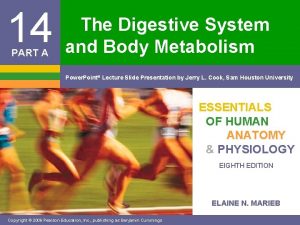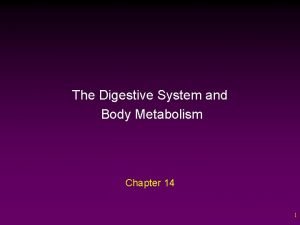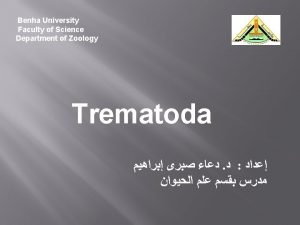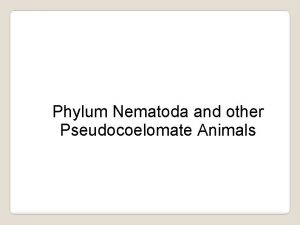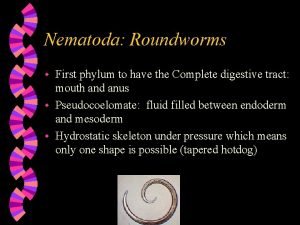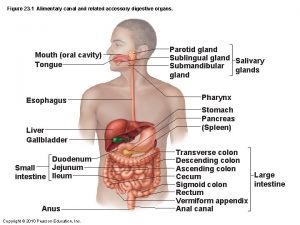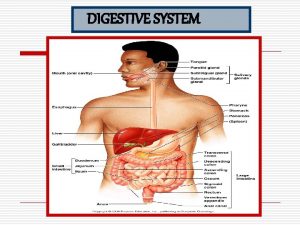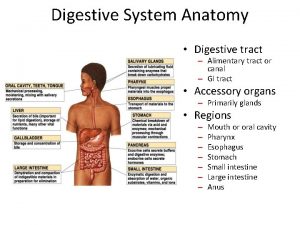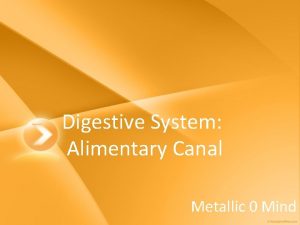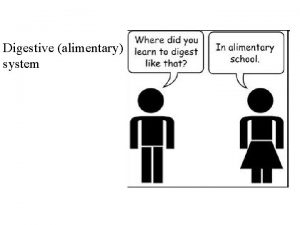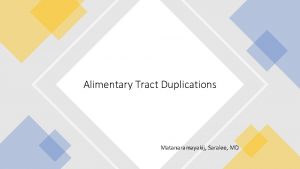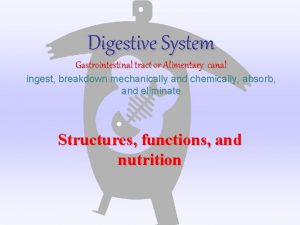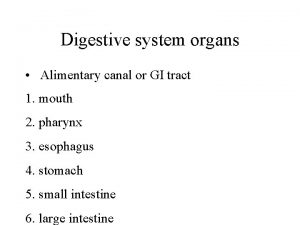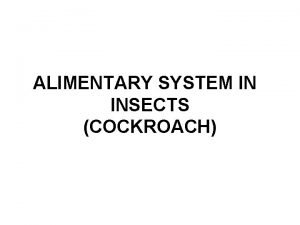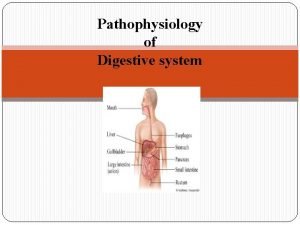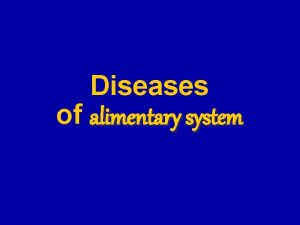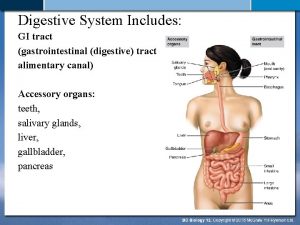DIGESTIVE SYSTEM STRUCTURE ALIMENTARY CANAL Digestive tract or














- Slides: 14

DIGESTIVE SYSTEM STRUCTURE

ALIMENTARY CANAL �Digestive tract or GI (gastrointestinal) tract � 30 ft. tube from mouth to anus �Consists of the mouth, throat, esophagus, stomach, small intestine, large intestine, and anus �See figure 18 -1 pg. 377

ACCESSORY ORGANS of DIGESTION �Tongue �Teeth �Salivary glands �Pancreas �Liver �Gall bladder

PERITONEUM �Lines abdominal cavity �Serous membrane � 2 layers: • Mesentery �Attaches to posterior wall of abdominal cavity �Small intestines are attached to this layer • Greater omentum �Anterior portion of wall �Hangs over the organs like a “protective apron” �Contains large amounts of fat

MOUTH (FIGURE 18 -2) � Called the oral or buccal cavity � Covered in ____ membrane � Roof has hard and soft palates • Hard palate: formed from maxillary and palatine bones • Soft palate: behind hard, made from a movable mucous membrane fold and separates the mouth from the nasopharnyx � Uvula • Hangs from soft palate • Cone-shaped flap of tissue • Prevents food from entering the nasal cavity when swallowing

SALIVARY GLANDS �Three pairs • Parotid, submandibular, and sublingual • Parotid – largest �Found on both sides of the face, in front and below ears �Become inflamed when an individual has mumps �See figure 18 -4

TEETH (FIGURE 18 -5 and 18 -6) �Gingiva – gums • Support and protect the teeth �Deciduous (baby teeth) – 20 • Start around 6 mons to 2 years and may last up to age 12 �Adult mouth has 32 teeth • Start about age 6 to 25 years (wisdom)

ESOPHAGUS � 10” long muscular tube �Connects pharynx and stomach �Wall of esophagus has 4 layers • Mucosa, submucosa, muscular, and external serous layer �The muscles in the upper 3 rd are voluntary and involuntary (smooth) on the lower part

STOMACH �Cardiac sphincter • Opening from esophagus �Pyloric sphincter • Regulates entrance of food into the duodenum �Rugae • Folds in the gastric mucosa �See figure 18 -8

SMALL INTESTINE �Can be up to 20’ long �Duodenum – 12” long • Curves around head of pancreas • Food comes from stomach • Gets digestive juices from pancreas and bile from liver �Jejunum – 8 ft. long �Ileum – 10 – 12 ft. long �See figure 18 -9

PANCREAS �Feather-shaped �Located behind stomach �Endocrine and exocrine gland �See figure 8 -12 pg. 388

LIVER �Largest organ in body �Located below the diaphragm, upper right quadrant �Connected to gallbladder and small intestine by ducts �Figure 8 -12

GALLBLADDER �Small, green organ �Inferior surface of liver �Figure 8 -12

LARGE INTESTINE (Figure 18 -13) � Colon � Approx 5’ long and 2” in diameter � Cecum • RLQ of abdomen • Blind pouch � Appendix • RLG below cecum • Fingerlike projection • No digestive function � Rectum • Opens to anus • 7 -8” long � Anus • Last portion of large intestine • Guarded by 2 sphincters � 1 internal, 1 external
 What is alimentary canal
What is alimentary canal Alimentary tract and metabolism
Alimentary tract and metabolism The third tunic from the inside of the alimentary canal
The third tunic from the inside of the alimentary canal What does the inside of a human stomach look like
What does the inside of a human stomach look like Human alimentary canal
Human alimentary canal Earthworm phylum
Earthworm phylum Digestive system
Digestive system Digestive histology
Digestive histology Alimentary canal of mammals
Alimentary canal of mammals Which is not part of the alimentary canal
Which is not part of the alimentary canal Ch 14 the digestive system and body metabolism
Ch 14 the digestive system and body metabolism Platyhelminthes alimentary canal
Platyhelminthes alimentary canal Pseudocoelomate phylum name
Pseudocoelomate phylum name First phylum with complete digestive system
First phylum with complete digestive system Alimentary canal
Alimentary canal


